Embroiderers
COUNTRIES
DRESS
A 14-year, award-winning global, collaborative embroidery project
The Red Dress project, conceived by British artist Kirstie Macleod, provides an artistic platform for individuals, particularly women, and communities around the world, many of whom are vulnerable and/or live in poverty, to tell their stories through embroidery.From 2009 to 2023, pieces of The Red Dress and later the completed garment travelled the globe being embroidered onto. Constructed out of 87 panels of burgundy silk dupion, the dress has been worked on by 367 women/girls, 11 men/boys and two non-binary artists from 51 countries, earning it a place in the Guinness World Records 2025 for the largest collaborative embroidery project. All 141 commissioned embroiderers were paid for their work and receive a portion of all ongoing exhibition fees and merchandise sales. Further embroidery was added by willing audiences at various exhibitions and events.
The dress’ embroiderers include female refugees from Palestine, Syria and Ukraine, women seeking asylum in the UK from Iran, Iraq, China, Nigeria and Namibia, survivors of war in Kosovo, Bosnia and Herzegovina, Rwanda and DR Congo, impoverished and disadvantaged women in South Africa, Mexico and Egypt, individuals in Kenya, Japan, Turkey, Jamaica, Sweden, Peru, Czech Republic, Dubai, Afghanistan, Australia, Argentina, Germany, Switzerland, Canada, Tobago, Vietnam, Estonia, USA, Russia, Pakistan, Wales, Colombia and England, students from Montenegro, Brazil, Malta, Singapore, Eritrea, Norway, Poland, Finland, Ireland, Romania and Hong Kong as well as artisans from embroidery studios in India and Saudi Arabia.
The dress also features pieces of Lambani embroidery gathered by Kirstie during her travels in southern India in 2002, honouring the hours she spent stitching alongside Lambani women. Without a common language these interactions unfolded through a shared love and understanding of stitch and embroidery. They had a profound effect on Kirstie and seven years later provided huge inspiration for creating The Red Dress.
.






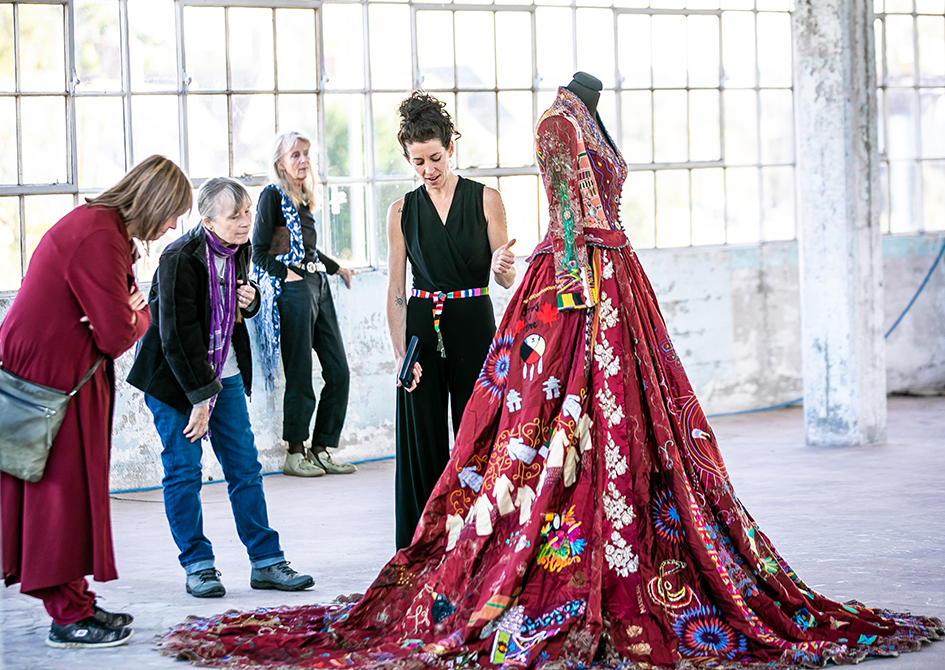






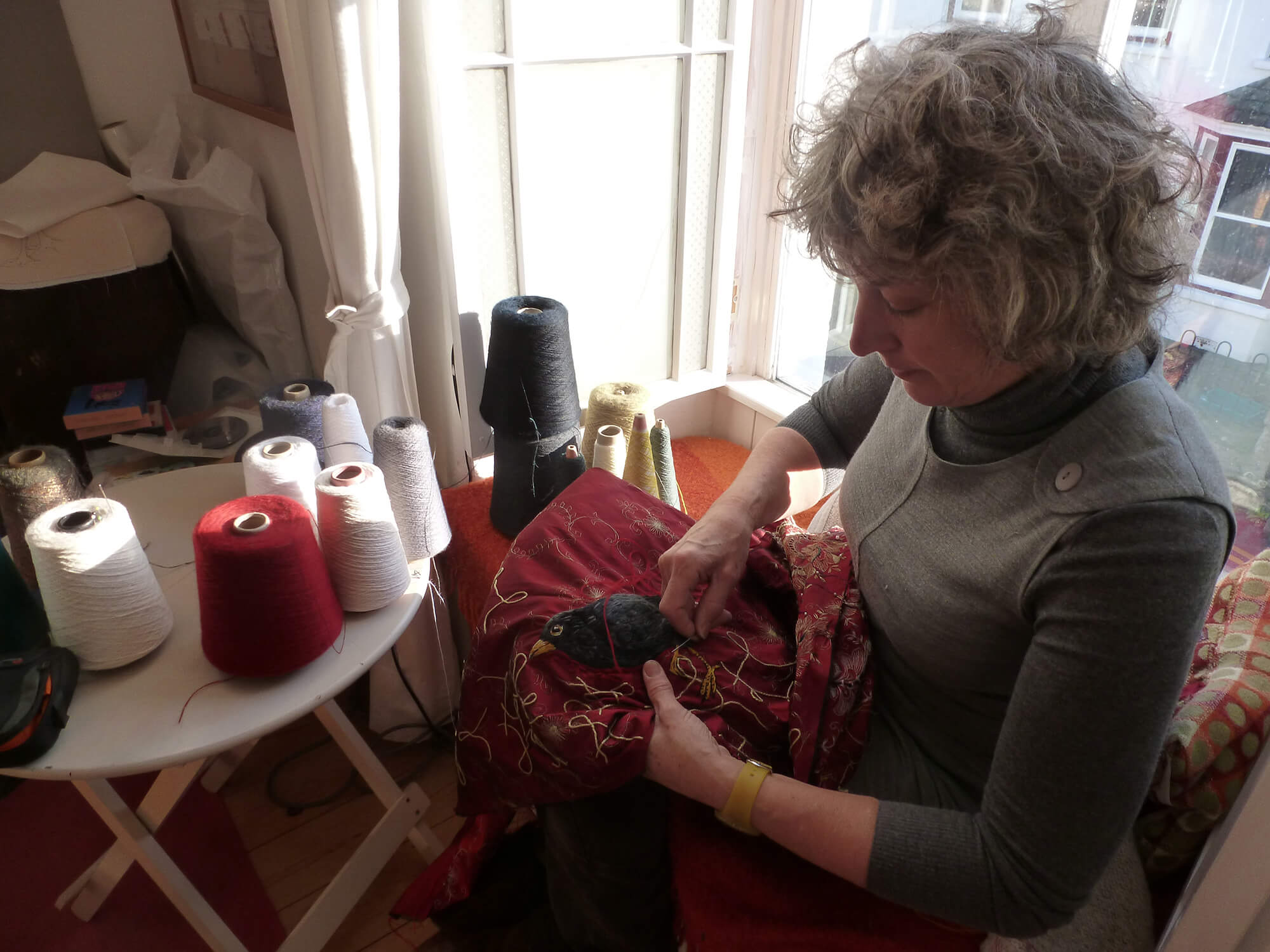







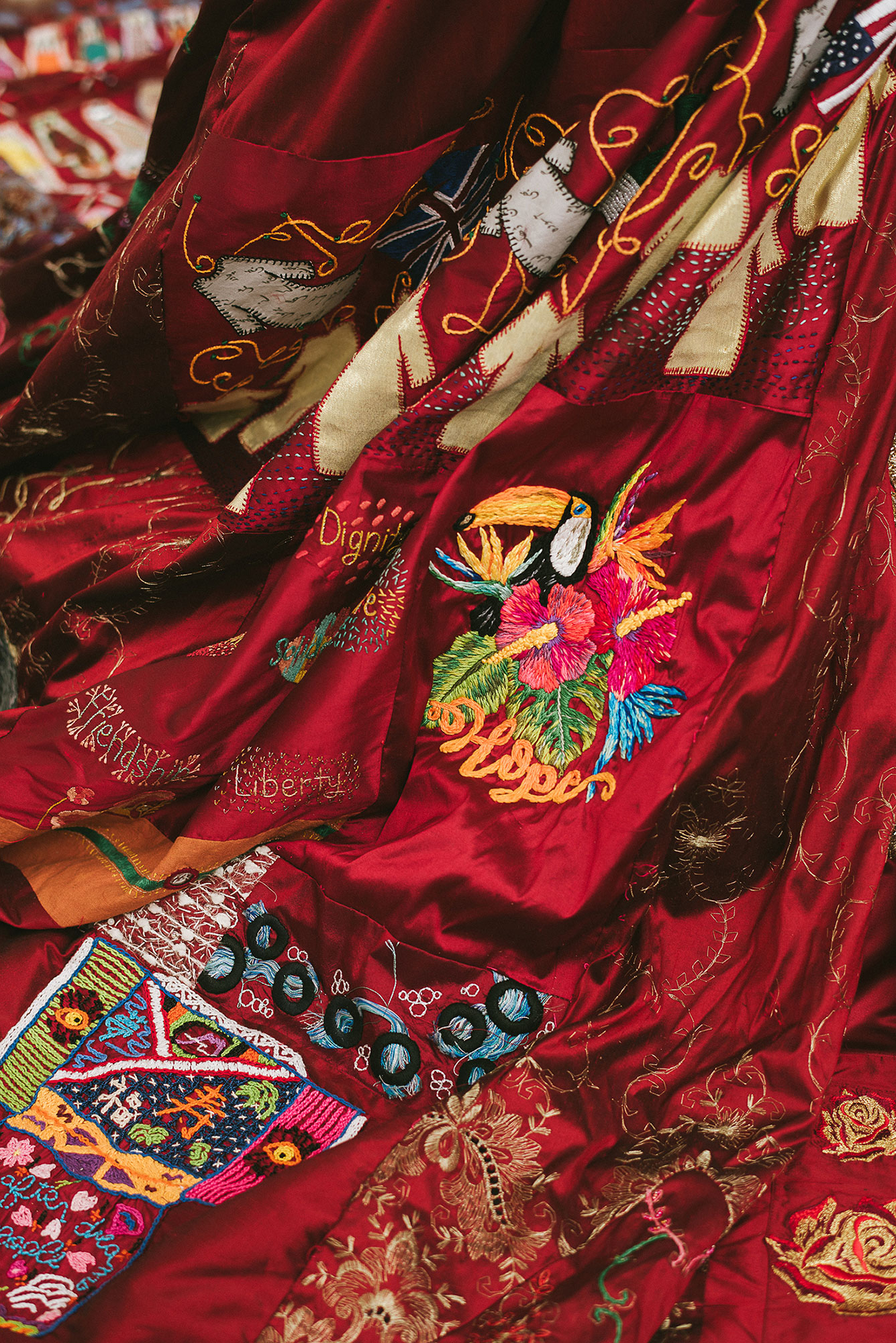
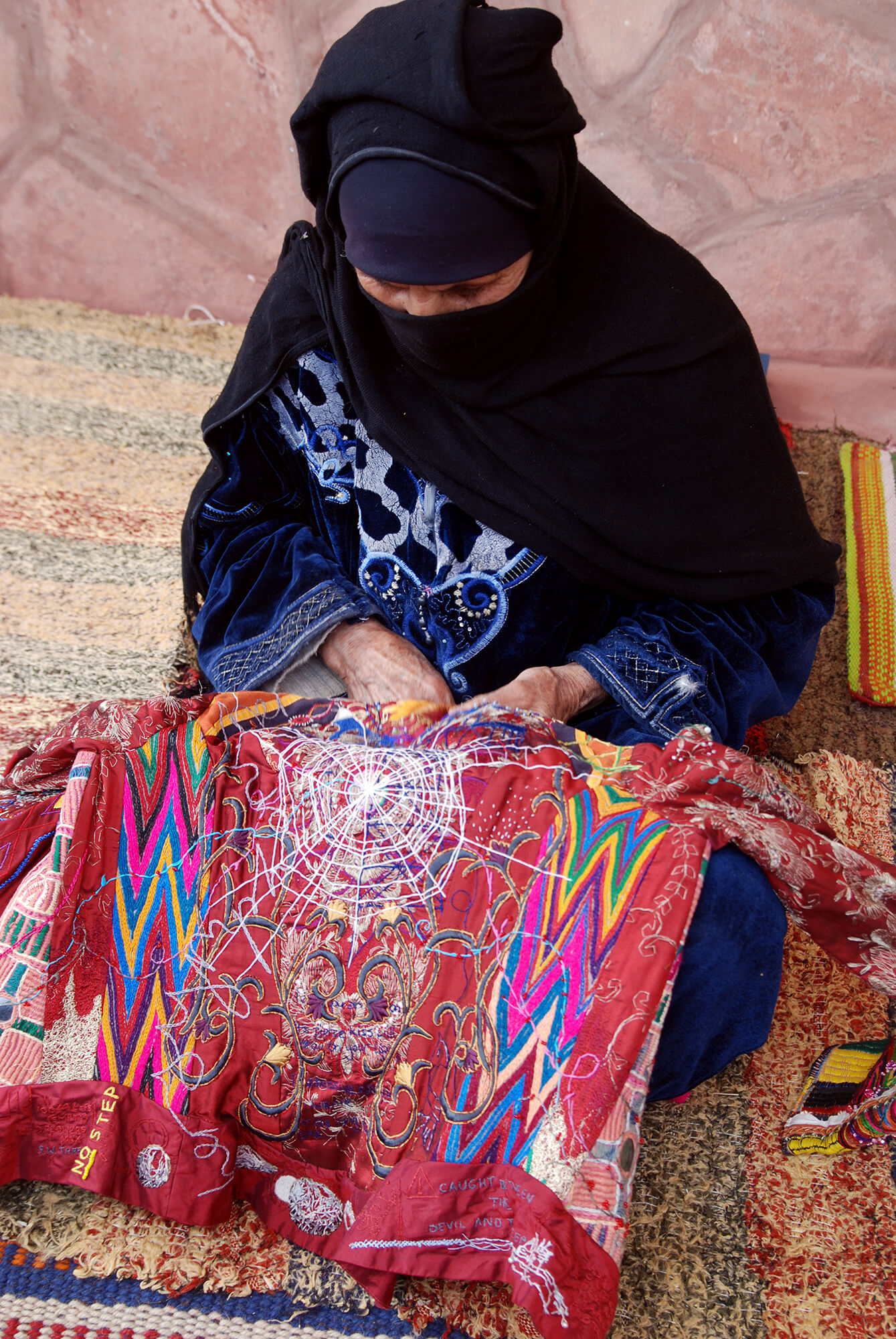



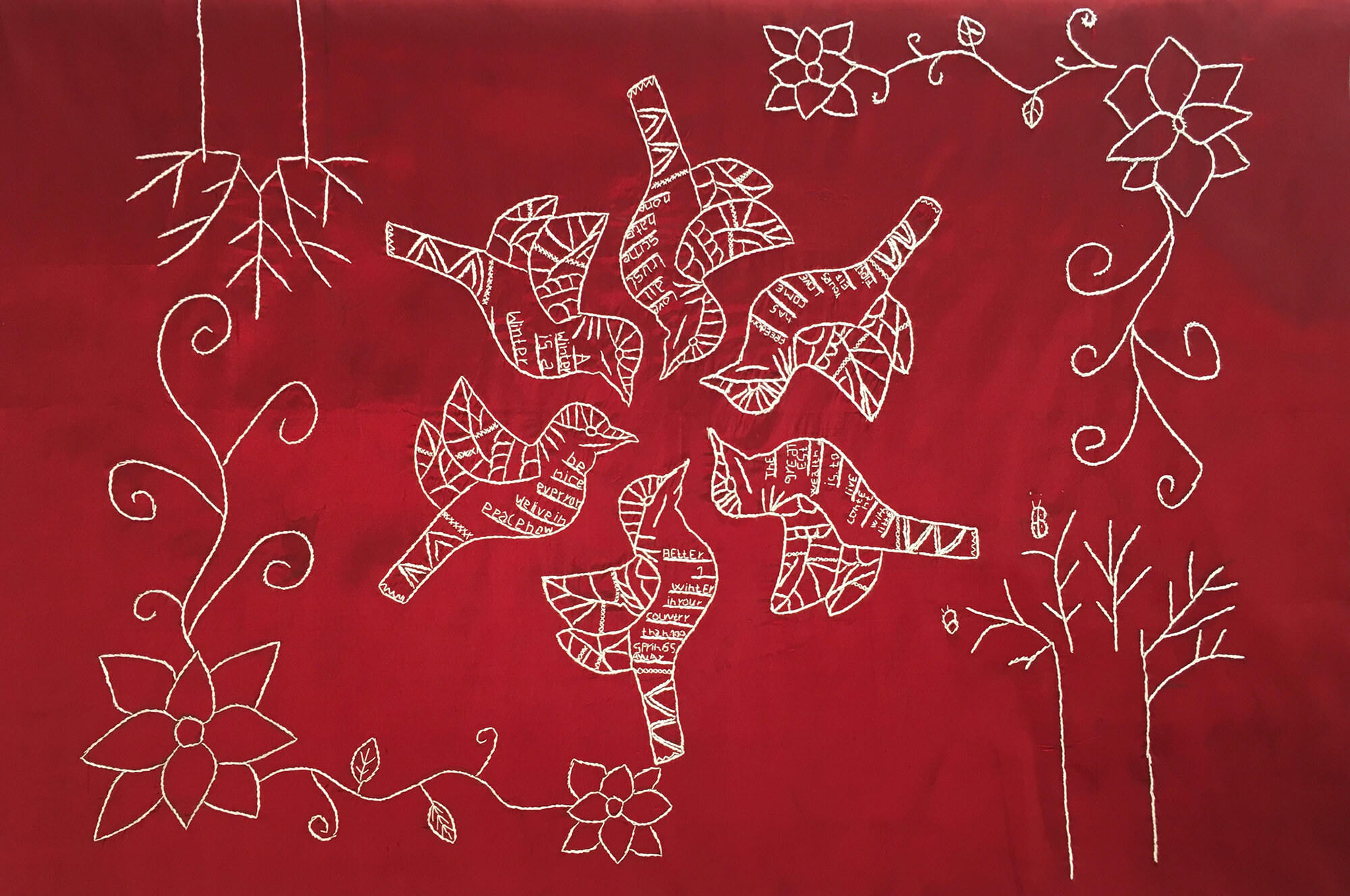



The intention of The Red Dress
Initially the project sought to generate a dialogue of identity through embroidery, uniting people around the world across borders and boundaries. However, over the 14 years it was created, The Red Dress also become a platform for self-expression and an opportunity for, often marginalised, voices to be amplified and heard, initiating vital dialogues on important and frequently uncomfortable issues.
Many of the artisans are established textile professionals, but there are also pieces contributed by first-time embroiderers. The artists were encouraged to create a work that represented them personally while also reflecting their culture and traditions. Some used embroidery styles practiced for hundreds of years within their family, village or town, while others chose simple stitches to convey powerful, at times traumatic, events from their past and the potential for healing through the act of voicing and processing their experiences via the dress. Some of the artisans are rebuilding their lives with the help of embroidery, using their skills or being trained in embroidery to earn a consistent living to support themselves and their communities.
The completed garment
The Red Dress’ 14-year creation journey around the world is now complete with the garment assembled in its final configuration. Covered in an estimated 1-1.5 billion stitches, the 6.8 kg. silk dress is weighted as much by the individual and collective stories it gives voice to as by the threads and beads that adorn it.
The Red Dress has been exhibited in major galleries and museums worldwide, including Galerie Maeght in Paris, Art Dubai, Museo De Arte Popular in Mexico City, the National Library of Kosovo, War Childhood Museum in Sarajevo, Southern Vermont Arts Center in Manchester, Frick Pittsburgh, Fuller Craft Museum in Massachusetts, National Waterfront Museum in Wales, Fashion and Textile Museum in London, Hampi Art Labs in India, an event at the Royal Academy of Arts in London and the Premio Valcellina Textiles Award in Maniago, Italy, where it won first prize in 2012.
The dress has also been the focus of political gatherings and was invited to the Parliamentary Assembly of the Council of Europe (PACE) Winter Session on Equality and Non-Discrimination in Strasbourg in January 2023 where two Ukrainian refugees contributed an embroidery during the event on behalf of all of the women of the assembly. A delegate later commented that they found The Red Dress a highly tangible way to further engage with the issues being discussed.
Moving forward, as well as continuing to develop a strong online presence through the Digital Red Dress and social media, the garment will be travelling to many different galleries, museums and event spaces around the world on its exhibition tour, with the aim to be accessible to all. Kirstie hopes to take the dress to visit the countries of all 141 commissioned embroiderers who contributed to it and exhibit The Red Dress alongside the artisans’ own work in their chosen venue. The Calico Garment initiative and other projects inspired by The Red Dress is supporting this vision.
With the help of funding and by collaborating with professionals, groups and charities, the project continues to ensure the dress touches the lives of audiences it might not otherwise reach, among them refugees, vulnerable individuals, those with complex needs, the visually impaired and blind and recovering addicts. Inclusivity is a cornerstone of The Red Dress and Kirstie was proud to display the garment at the FLINT Festival of Rights (Female, Lesbian, Intersex, Non-binary, Trans) in 2023 which included sessions on tackling gender-based violence.
Support for the project
Practical and logistical support for commissions for The Red Dress was provided by the following charities, self-help development projects, social enterprises and various initiatives providing support to women in poverty: Manchester Aid to Kosovo supporting Sister Stitch in Kosovo, KISANY in Rwanda and DR Congo, Missibaba in South Africa, Kitzen in Mexico, Al Badia in Lebanon supporting Palestinan refugees, FanSina in Egypt, the Swansea Women’s Asylum and Refugee Support Group in Wales, White Ribbon Alliance in the UK and the War Childhood Musuem in Bosnia and Herzegovina.
Seed investment for the project was provided by the British Council Dubai in 2009, with subsequent funding received from the Arts Council England National Lottery Fund, three British Embassies, Contemporary Middle East, Southern Vermont Arts Center, Frick Pittsburgh and Fuller Craft Museum, USA, JSW Foundation, India, hundreds of individuals around the world via three crowdfunding campaigns as well as private donations.
OUR SUPPORTERS
A huge thank you to all who have given their time, energy, enthusiasm, advice, experience and support to The Red Dress project over the years.
In addition to the organisations below, funding has been gratefully received from a number of private donations and via three crowdfunding campaigns in 2020, 2022 and 2024.
In addition to the organisations below, funding has been gratefully received from a number of private donations and via three crowdfunding campaigns in 2020, 2022 and 2024.












"
"